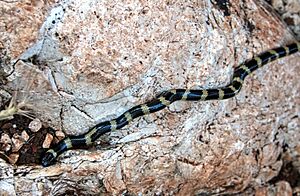Micrelaps muelleri facts for kids
Quick facts for kids Micrelaps muelleri |
|
|---|---|
 |
|
| Conservation status | |
| Scientific classification | |
| Genus: |
Micrelaps
|
| Species: |
muelleri
|
Common names: Müller's black-headed snake, Mueller's two-headed snake, Muller's snake.
The Micrelaps muelleri is a special type of snake. It has fangs at the back of its mouth and a mild venom. This snake belongs to the Lamprophiidae family. You can only find this snake in the Middle East.
Contents
About the Müller's Black-Headed Snake
Scientists group living things into categories. A species is a group of animals that can have babies together. A genus is a larger group that includes several similar species. The Müller's black-headed snake is the main example for its group, called the Micrelaps genus. There are no different types (subspecies) of this snake.
Why is it Called Muelleri?
The name muelleri was given to this snake to honor a Swiss scientist. His name was Fritz Müller. He studied reptiles and amphibians.
Where Does This Snake Live?
You can find the Micrelaps muelleri in several countries in the Middle East. These include Palestine, Jordan, Lebanon, and Syria.
What Does the Müller's Black-Headed Snake Look Like?
This snake is mostly black. It has rings that are whitish and have a zigzag edge. These rings can be wider or narrower than the black parts between them. They are usually broken on the snake's belly.
Adult snakes can grow to be about 40.5 centimeters (about 16 inches) long. Their tail is usually around 3 centimeters (about 1 inch) long.
The scales on its back are smooth. They are arranged in 15 rows around the middle of its body. The scales on its belly are called ventral scales. There are usually between 251 and 275 of these. The scale near its vent (where waste leaves the body) is divided into two parts. The scales under its tail are also divided. There are usually between 26 and 32 of these.
The snake's head is very flat. The scale at the tip of its nose is almost twice as wide as it is deep. You can just barely see it from above. The scales between its nostrils are a bit wider than they are long. They are also shorter than the scales in front of its eyes. The scale on top of its head (the frontal scale) is small. It is not wider than the scales above its eyes. It is about 1⅔ times as long as it is wide. This scale is about half as long as the scales at the back of its head. Each scale above its eyes is as long as it is wide.
There is a small scale behind each eye that touches the first scale on its temple. The scales on its temples are arranged in a pattern of 1+1 or 1+2. It has seven upper lip scales, with the third and fourth ones touching the eye. There are three or four lower lip scales that touch the front chin shield. The front chin shields are as long as the back chin shields.
Reproduction
The Micrelaps muelleri is an oviparous snake. This means that the female snake lays eggs.
Where Does This Snake Live? (Habitat)
The Micrelaps muelleri likes to live in certain places. Its favorite homes include areas with Mediterranean-style bushes and trees. It also lives in farmland.
How is This Snake Doing? (Conservation Status)
The Micrelaps muelleri is listed as "least concern" (LC) by the IUCN Red List of Threatened Species. This means that scientists are not worried about it disappearing. Even though it lives in a somewhat small area, there are no big threats to it right now. It also lives in some protected areas, which helps keep it safe.


